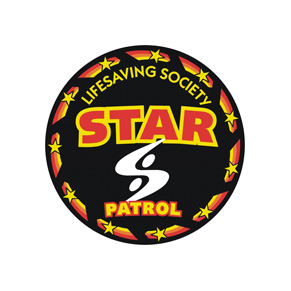At a glance
Star Patrol demands good physical conditioning and lifesaving
judgment. Participants develop lifesaving and first aid skills;
further refine front crawl, back crawl and breaststroke over 100 m
each; and complete 600 m workouts and 300 m timed swims.

- Demonstrate AT LEAST TWO different entries with different
aids.
- Entry with aid and swim 25 m or yd. head-up front crawl or
breaststroke. Assume ready position and demonstrate ability to
scull forward, backward and turn.
- Demonstrate defence methods from the front, side and rear.
- Demonstrate eggbeater kick showing ability to travel, change
direction and height levels.
- Carry a 4.5 kg (10 lb.) object 25 m or yd. using swimmer's
choice of lifesaving kick.
- :::
- Demonstrate the removal of an unconscious victim with the
assistance of an untrained bystander.
- Head-up approach into head-first surface dive to a maximum
depth of 2 m. Swim underwater for 5-10 m or yd. and surface.
Foot-first surface dive (maximum depth 2 m), recover an object and
return it to the starting point.
- Demonstrate in shallow water, the ability to turn a victim
face-up and support the face above the surface.
- Swim front crawl, back crawl, and breaststroke (100 m or yd.
each).
- Complete a 600 m or yd. workout at least 3 times during the
training course. Warm-up: 25 m or yd. lifesaving kick, and 50 m or
yd. each of back crawl, breaststroke, front crawl; Stroke drills: 5
x 25 m or yd.; Work set: 4 x 50 m or yd. on 90 sec.; Cool
down: 100 m or yd.
- Swim 300 m in 9 minutes or better (300 yd. in 8:00 min.) using
any stroke or combination of strokes of the swimmer's choice.
- Demonstrate the recognition and care of a bone or joint
injury.
- Demonstrate the recognition and care of a victim suffering
respiratory distress from asthma or a severe allergic
reaction.
- From 3 different heights or positions, locate and describe an
object located on the bottom or below the surface.
- Perform a rescue of a weak swimmer or non-swimmer with a towing
aid. Swim approach 20 m or yd. and tow victim to safety showing
ability to avoid contact. Rescuer performs appropriate follow-up
procedures, including treatment for shock.